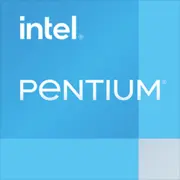Intel Pentium 2127U

インテル ペンティアム 2127U: 2025年の基本的な作業向けのバジェットプロセッサー
2025年4月
技術の急速な進歩にもかかわらず、市場には依然として高性能を必要としない人々のためのエントリーレベルのノートパソコンが販売されています。インテル ペンティアム 2127Uは、そのようなプロセッサーの一例であり、数年が経過してもなおバジェットセグメントでの関連性を保っています。2025年にこのソリューションがどのようなユーザーに向いているのか、そしてどのような妥協が必要かを見ていきましょう。
アーキテクチャとプロセス技術: 限られた機能
コア、スレッド、周波数
ペンティアム 2127Uは、2012〜2013年にリリースされたアイビー・ブリッジ(3世代目インテルコア)アーキテクチャに属しています。プロセス技術は22nmで、2025年には時代遅れと見なされます(現代のチップは5〜7nmを使用しています)。
- コア数: 2、スレッド数: 2 — ハイパースレッディングがないため、マルチタスクの能力が制限されています。
- ベースクロック: 1.9GHz、ターボモードはサポートされていません。
- キャッシュ: 2MB L3。
統合グラフィックス
内蔵GPUはインテルHDグラフィックス(アイビー・ブリッジ)、350〜1100MHzです。グラフィックスは基本的な作業向けに設計されています:
- フルHDでの動画再生。
- MinecraftやTerrariaのような軽量ゲームを低設定(30FPSまで)でプレイ。
- DirectX 11をサポートしていますが、現代のAV1コーデックに対するハードウェアアクセラレーションはありません。
消費電力とTDP: 効率性とパワーのバランス
プロセッサーのTDPは17Wです。これにより、アクティブ冷却なしで薄型ノートパソコンやコンパクトクーラーでの使用が可能となります。
特長:
- 低熱放出: ノートパソコンは、長時間の負荷時でも過熱しません。
- エネルギー効率技術のサポート: インテルスピードステップ(動的周波数変更)、C状態(未使用のブロックのシャットダウン)。
ただし、インテルスレッドディレクターのような現代の基準がないため(第12世代以降)、負荷管理の柔軟性が低下しています。
パフォーマンス: 現実的な期待
オフィス作業とマルチメディア
- オフィスアプリケーション(Microsoft 365、Google Workspace): ドキュメント、スプレッドシート、プレゼンテーションの作業は遅延なしで行えます。
- ウェブサーフィン: ブラウザ(Chrome、Edge)で5〜10タブの快適な作業が可能ですが、重いサイト(例: FigmaやCanva)を開くと速度が低下します。
- 動画: YouTubeの1080p動画視聴、ストリーミングサービス(Netflix、Twitch)。4Kはサポートされていません。
ゲーム
- 古いゲーム: Half-Life 2やCS:GOを最低設定(720p、25〜35FPS)でプレイ可能。
- インディーゲーム: Stardew Valley、Hollow Knight — 安定して60FPS。
- 現代のゲーム: FortniteやGenshin Impactは起動しません。
ターボモード: 不在。周波数は1.9GHzに固定されており、ピークパフォーマンスが制限されています。
使用シナリオ: このプロセッサーは誰のためのものか?
1. 学生: テキスト作成、オンラインコース、Zoom会議。
2. 高齢者: 使用の簡便さ、ハードウェアに対する要求が少ない。
3. オフィススタッフ: ドキュメントやメールの基本的な作業。
4. 予備のノートパソコン: 旅行用や二台目のデバイスとして。
適さない用途:
- 動画編集や3Dモデリング。
- 高要求な現代OSの動作(例: Windows 12)。
バッテリー持続時間: どのくらい持つか?
バッテリー容量が40〜50Whの場合、混合使用(ウェブサーフィン、動画視聴)で6〜8時間の稼働が期待できます。
省エネ技術:
- インテルスマートコネクト: スリープ状態でのアプリのバックグラウンド更新。
- パネルセルフリフレッシュ: 静的な画像時のGPU負荷を軽減。
しかし、2023年以降のプロセッサーのようなAI最適化のサポートがないため、アクティブな使用時のバッテリー持続時間は予測が困難です。
競合との比較: 誰が優れているか?
AMD Athlon Silver 3050e (2020年)
- 2コア、2スレッド、TDP 6W。
- より優れたグラフィックス(Radeon Vega 3)、4Kサポート。
- ノートパソコンの価格: 350〜400ドル。
Apple M1 (2020年)
- 8コア、18時間の稼働。
- パフォーマンスは4〜5倍。
- 価格: 999ドル(新しいMacBook Airから)。
結論: ペンティアム 2127Uは2020年代のバジェットモデルにも劣りますが、価格面では勝っています(ノートパソコンは250ドルから)。
長所と短所
強み:
- 低価格のデバイス。
- 冷静な動作と静音ファン。
- 基本的な作業には十分。
弱み:
- Windows 12をサポートしていない(Windows 10/11のみ、制限あり)。
- AIツール向けのハードウェア加速なし。
- アップグレードの選択肢が乏しい: 最大8〜16GBのRAMおよびSATA SSD。
ノートパソコン選択の推奨事項
1. デバイスの種類: ウルトラスリムまたはバジェットChromebook。
2. 必須スペック:
- 256GBのSSD(HDDは不可!)。
- 8GBのRAM(4GBではブラウザ使用でも不足)。
- 1920×1080の解像度の画面。
3. 避けるべき: このCPUを搭載したゲーミングノートパソコンやワークステーション — 期待に応えられません。
2025年モデルの例:
- Lenovo IdeaPad Slim 3(279ドル): 14インチ屏、8GB RAM、256GB SSD。
- HP 15s-eq2000(299ドル): 15.6インチFHD、Wi-Fi 6。
最終結論: ペンティアム 2127Uに向いているのは誰か?
このプロセッサーは以下のようなユーザーに適しています:
- テキスト作成、インターネット、動画用のできるだけ安価なノートパソコンを探している人。
- リソースを消費するアプリケーションを使用する予定がない人。
- 長時間のバッテリーもちと静音性を重視する人。
主なメリット:
- 300ドル未満の価格。
- 検証済みアーキテクチャの信頼性。
- エネルギー効率。
ただし、予算が100〜150ドル追加できるなら、2023年のインテルN100プロセッサーやAMD Ryzen 3 7320Uを搭載したノートパソコンを選ぶ方が良いでしょう。これらのパフォーマンスとサポート期間は大幅に向上します。
基本
CPUの仕様
メモリ仕様
GPUの仕様
その他
ベンチマーク
他のCPUとの比較
ソーシャルメディアで共有する
または当サイトへのリンクを追加
<a href="https://cputronic.com/ja/cpu/intel-pentium-2127u" target="_blank">Intel Pentium 2127U</a>